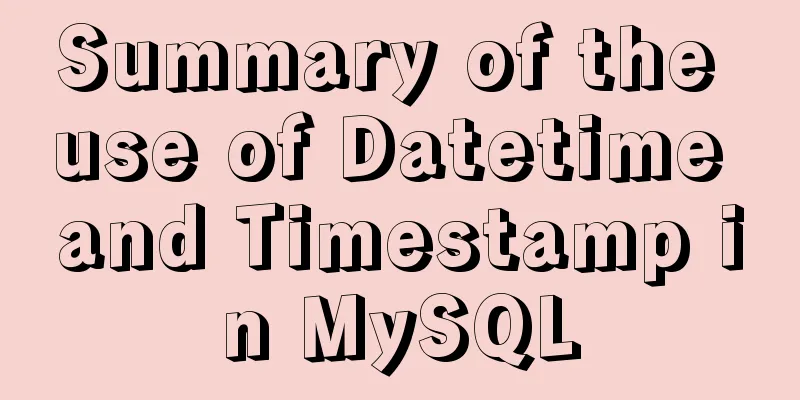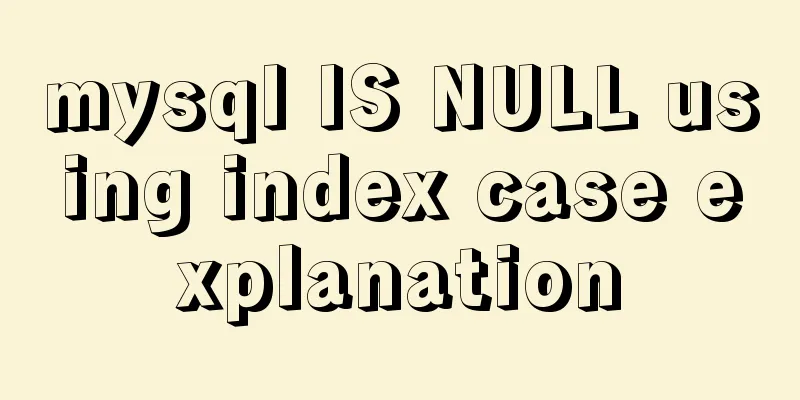Summary of the use of Datetime and Timestamp in MySQL

1. How to represent the current time in MySQL?In fact, there are many ways to express it, which are summarized as follows:
2. Comparison between TIMESTAMP and DATETIMEA complete date format is as follows: YYYY-MM-DD HH:MM:SS[.fraction], which can be divided into two parts: date part and time part. The date part corresponds to the "YYYY-MM-DD" format, and the time part corresponds to the "HH:MM:SS[.fraction]" format. For the date field, it only supports the date part. If the time part is inserted, it will discard the content of that part and prompt a warning. As shown below: mysql> create table test(id int, hiredate date); Query OK, 0 rows affected (0.01 sec) mysql> insert into test values(1,'20151208000000'); Query OK, 1 row affected (0.00 sec) mysql> insert into test values(1,'20151208104400'); Query OK, 1 row affected, 1 warning (0.01 sec) mysql> select * from test; +------+------------+ | id | hiredate | +------+------------+ | 1 | 2015-12-08 | | 1 | 2015-12-08 | +------+------------+ 2 rows in set (0.00 sec) Note: The first one does not prompt a warning because its time part is 0 Similarities between TIMESTAMP and DATETIME:1> Both can be used to represent dates of the type YYYY-MM-DD HH:MM:SS[.fraction]. The differences between TIMESTAMP and DATETIME are:1> The storage methods of the two are different For TIMESTAMP, it converts the time inserted by the client from the current time zone to UTC (Coordinated Universal Time) for storage. When querying, it is converted into the client's current time zone and returned. For DATETIME, no changes are made and it is basically input and output as is. Next, let's verify First, create two test tables, one using timestamp format and one using datetime format. mysql> create table test(id int, hiredate timestamp); Query OK, 0 rows affected (0.01 sec) mysql> insert into test values(1,'20151208000000'); Query OK, 1 row affected (0.00 sec) mysql> create table test1(id int, hiredate datetime); Query OK, 0 rows affected (0.01 sec) mysql> insert into test1 values(1,'20151208000000'); Query OK, 1 row affected (0.00 sec) mysql> select * from test; +------+---------------------+ | id | hiredate | +------+---------------------+ | 1 | 2015-12-08 00:00:00 | +------+---------------------+ 1 row in set (0.01 sec) mysql> select * from test1; +------+---------------------+ | id | hiredate | +------+---------------------+ | 1 | 2015-12-08 00:00:00 | +------+---------------------+ 1 row in set (0.00 sec) The output of both is the same. Secondly, change the time zone of the current session mysql> show variables like '%time_zone%'; +------------------+--------+ | Variable_name | Value | +------------------+--------+ | system_time_zone | CST | | time_zone | SYSTEM | +------------------+--------+ 2 rows in set (0.00 sec) mysql> set time_zone='+0:00'; Query OK, 0 rows affected (0.00 sec) mysql> select * from test; +------+---------------------+ | id | hiredate | +------+---------------------+ | 1 | 2015-12-07 16:00:00 | +------+---------------------+ 1 row in set (0.00 sec) mysql> select * from test1; +------+---------------------+ | id | hiredate | +------+---------------------+ | 1 | 2015-12-08 00:00:00 | +------+---------------------+ 1 row in set (0.01 sec) The "CST" above refers to the system time of the host where MySQL is located, which is the abbreviation of China Standard Time, China Standard Time UT+8:00 The results show that the time returned in test is 8 hours earlier, while the time in test1 remains unchanged. This fully verifies the difference between the two. 2> The time range that can be stored by the two is different The time range that timestamp can store is: '1970-01-01 00:00:01.000000' to '2038-01-19 03:14:07.999999'. The time range that datetime can store is: '1000-01-01 00:00:00.000000' to '9999-12-31 23:59:59.999999'. Summary: TIMESTAMP and DATETIME are not much different except for their storage range and storage method. Of course, TIMESTAMP is more appropriate for cross-time zone business. 3. Automatic initialization and update of TIMESTAMP and DATETIMEFirst, let's look at the following operations
mysql> create table test(id int, hiredate timestamp);
Query OK, 0 rows affected (0.01 sec)
mysql> insert into test(id) values(1);
Query OK, 1 row affected (0.00 sec)
mysql> select * from test;
+------+---------------------+
| id | hiredate |
+------+---------------------+
| 1 | 2015-12-08 14:34:46 |
+------+---------------------+
1 row in set (0.00 sec)
mysql> show create table test\G
*************************** 1. row ***************************
Table: test
Create Table: CREATE TABLE `test` (
`id` int(11) DEFAULT NULL,
`hiredate` timestamp NOT NULL DEFAULT CURRENT_TIMESTAMP ON UPDATE CURRENT_TIMESTAMP
) ENGINE=InnoDB DEFAULT CHARSET=latin1
1 row in set (0.00 sec)
Does it look a bit strange? I did not insert the hiredate field, and its value was automatically changed to the current value. Moreover, when creating the table, I did not define the "DEFAULT CURRENT_TIMESTAMP ON UPDATE CURRENT_TIMESTAMP" shown in the "show create table test\G" result. In fact, this feature is Automatic Initialization and Updating. Automatic initialization means that if there is no explicit assignment to the field (such as the hiredate field in the above example), it is automatically set to the current system time. Automatic update means that if other fields are modified, the value of this field will be automatically updated to the current system time. It is related to the "explicit_defaults_for_timestamp" parameter. By default, the value of this parameter is OFF, as shown below: mysql> show variables like '%explicit_defaults_for_timestamp%'; +---------------------------------+-------+ | Variable_name | Value | +---------------------------------+-------+ | explicit_defaults_for_timestamp | OFF | +---------------------------------+-------+ 1 row in set (0.00 sec) Let’s take a look at the official description below:
Many times, this is not what we want. How to disable it? 1. Set the value of "explicit_defaults_for_timestamp" to ON. 2. The value of "explicit_defaults_for_timestamp" is still OFF. There are two ways to disable it. 1> Use the DEFAULT clause to specify a default value for the column 2> Specify the NULL attribute for the column. As shown below:
mysql> create table test1(id int, hiredate timestamp null);
Query OK, 0 rows affected (0.01 sec)
mysql> show create table test1\G
*************************** 1. row ***************************
Table: test1
Create Table: CREATE TABLE `test1` (
`id` int(11) DEFAULT NULL,
`hiredate` timestamp NULL DEFAULT NULL
) ENGINE=InnoDB DEFAULT CHARSET=latin1
1 row in set (0.00 sec)
mysql> create table test2(id int, hiredate timestamp default 0);
Query OK, 0 rows affected (0.01 sec)
mysql> show create table test2\G
*************************** 1. row ***************************
Table: test2
Create Table: CREATE TABLE `test2` (
`id` int(11) DEFAULT NULL,
`hiredate` timestamp NOT NULL DEFAULT '0000-00-00 00:00:00'
) ENGINE=InnoDB DEFAULT CHARSET=latin1
1 row in set (0.00 sec)
Prior to MySQL 5.6.5, Automatic Initialization and Updating was applicable only to TIMESTAMP, and at most one TIMESTAMP field in a table was allowed to use this feature. As of MySQL 5.6.5, Automatic Initialization and Updating applies to both TIMESTAMP and DATETIME values, with no limit on the number of values. refer to:1. http://dev.mysql.com/doc/refman/5.6/en/datetime.html 2. http://dev.mysql.com/doc/refman/5.6/en/timestamp-initialization.html This is the end of this article about the summary of the use of Datetime and Timestamp in MySQL. For more relevant MySQL Datetime and Timestamp content, please search 123WORDPRESS.COM's previous articles or continue to browse the following related articles. I hope everyone will support 123WORDPRESS.COM in the future! You may also be interested in:
|
<<: CSS realizes corner cutting + border + projection + content background color gradient effect
>>: Detailed introduction to deploying k8s cluster on centos7 system
Recommend
td content automatically wraps table table td after setting the width too much text automatically wraps
Set the table's style="table-layout:fixed...
Example verification MySQL | update field with the same value will record binlog
1. Introduction A few days ago, a development col...
Detailed explanation of the initialization mechanism in bash
Bash Initialization Files Interactive login shell...
The process of installing and configuring nginx in win10
1. Introduction Nginx is a free, open source, hig...
Javascript front-end optimization code
Table of contents Optimization of if judgment 1. ...
Implementation of CSS Fantastic Border Animation Effect
Today I was browsing the blog site - shoptalkshow...
Using CSS3 to achieve transition and animation effects
Why should we use CSS animation to replace JS ani...
How to implement a lucky wheel game in WeChat applet
I mainly introduce how to develop a lucky wheel g...
Vue implements card flip carousel display
Vue card flip carousel display, while switching d...
Solve the problem of running hello-world after docker installation
Installed Docker V1.13.1 on centos7.3 using yum B...
Detailed explanation of the murder caused by a / slash in Nginx proxy_pass
background An nginx server module needs to proxy ...
Specific use of the autoindex module in the Nginx Http module series
The main function of the brower module is to dete...
Detailed explanation of adding click event in echarts tooltip in Vue
Table of contents need Workaround 1. Set tooltip ...
Alibaba Cloud Server Ubuntu Configuration Tutorial
Since Alibaba Cloud's import of custom Ubuntu...
Detailed explanation of the role of explain in MySQL
1. MYSQL index Index: A data structure that helps...









